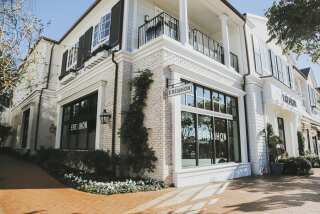Two home-building partners are caught in the middle — again
Southern California home builders Richard Ashby and Lawrence Redman were running short on resources, but not ambition.
Already heavily in debt and with signs of a recession on the horizon, the developers needed more money, this time to build several hundred homes in southeastern Riverside County.
So they turned to Pasadena-based IndyMac Bank in 2006 for a much-needed capital infusion. They got their $40-million loan, but what unfolded was an all-too-familiar horror story as the national recession slammed the Inland Empire economy.
Country View Estates in Menifee was never completed. The developers defaulted on the loans. IndyMac failed and was taken over by the Federal Deposit Insurance Corp.
Now, the failed loan is at the center of the federal government’s latest effort to get tough on bankers it blames for the collapse of the real estate and credit markets.
In a lawsuit filed this month, the FDIC accused four former executives in IndyMac’s home builder lending division of approving ill-advised loans that helped cause the bank’s collapse and forced the federal government to step in with an infusion of money. The suit seeks $300 million in damages.
The FDIC had strong motivation to go after the former executives. IndyMac’s collapse could end up costing the federal insurance fund $11 billion to cover bad loans — mostly residential mortgages — and other expenses related to the failure, FDIC officials have estimated.
The loan to Ashby and Redman was destined to fail, the lawsuit said, because the Inland Empire was overbuilt and because the developers were highly leveraged, making their personal guarantees to repay the loan worthless.
But the defendants contend there is no way they could have anticipated what happened to the Inland Empire real estate market, an assessment shared by some legal analysts.
“The idea that you shouldn’t have made loans in the Inland Empire, that’s a stretch in my opinion,” said Dan Schechter, a professor at Loyola Law School in Los Angeles and co-author of the book “California Real Estate Finance.”
Malpractice lawsuits are common problems for doctors and lawyers, but not something loan executives expect to face. If the lawsuit prevails, Schechter said, it could have a chilling effect in the loan business.
“If we’re talking about simple, ordinary negligence as being a source of liability, that might be terrifying for loan officers,” he said.
According to the FDIC suit, IndyMac had $900 million in outstanding loans to real estate developers when the bank failed in 2008. Losses from those loans are expected to reach $500 million.
The $40-million loan to Ashby and Redman was among those bad loans. Ashby and Redman each signed personal guarantees promising to repay the money if their company defaulted. But the home builders had already guaranteed $100 million worth of other loans, far in excess of their net worth, the FDIC said in its lawsuit. And the value of the collateral fell after the real estate market collapsed.
IndyMac ultimately sued Ashby and Redman in 2008 in an as-yet-unsuccessful attempt to recoup more than $34 million in unpaid principal and interest from three loans it had made to the home builders’ company, Fiesta Development Inc.
IndyMac, now known as OneWest Bank, eventually sold the delinquent loans to a third party.
Forced into an involuntary bankruptcy by other unpaid creditors, Redman settled his debt with IndyMac’s successors this year by agreeing to pay $3.25 million, court documents show.
Ashby is under a court order to pay $29 million to the company that now owns the loans, but he said in an interview he does not expect to be able to pay it.
Ashby, who spent more than 40 years in the home construction business and now lives in Huntington Beach, said in an interview that the FDIC is not justified in criticizing the former IndyMac executives.
He said he had never defaulted on a loan in a career in which he built thousands of homes, making him a suitable borrower.
“In my opinion, unfortunately, they’re scapegoats,” Ashby said. “It’s a witch hunt looking for someone to blame.
“No one realized the worldwide recession was going to hit. I don’t think any of these gentlemen made a bad decision with us. We had paid every other loan back on time.”
Redman, in a statement filed in Bankruptcy Court, said he too had been a successful builder, for more than 30 years — until the real estate and credit markets collapsed. The difficulties he and Ashby experienced were common in the home-building market, he said in the statement.
“He believes the loan was adequately collateralized and he had an excellent credit history, having never defaulted on a loan or missed payments to anybody,” said Redman’s attorney, Stanley Goldich. “Obviously things changed with the value of the collateral.”
Attorneys for the four former IndyMac executives echoed those sentiments, saying the real estate market downturn was to blame for borrowers’ inability to repay loans.
The FDIC said in its July 10 lawsuit that IndyMac officials should have known that the Inland Empire was saturated with new homes and would be unlikely to sustain the rapid growth necessary for Ashby and Redman’s project to succeed.
The suit also said that Redman and Ashby were highly leveraged and had very low liquidity and low net worth.
“It sounds like in this case not enough due diligence was undertaken by IndyMac to be sure the developers were not overextending themselves with respect to the guarantees,” said James Barth, a former chief economist for the Office of Thrift Supervision and now a finance professor at Auburn University in Alabama.
“The problem is it’s not a particularly good business model if the only way people can repay the loans is if home prices go up continuously year in, year out.”
More to Read
Inside the business of entertainment
The Wide Shot brings you news, analysis and insights on everything from streaming wars to production — and what it all means for the future.
You may occasionally receive promotional content from the Los Angeles Times.











